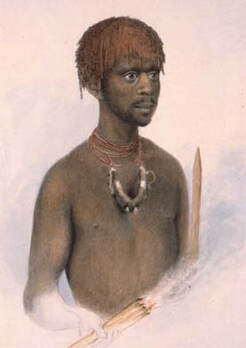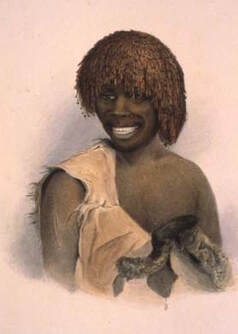 Maulboyheenner (aka Timmy), Thomas Bock (1837-1847).
Maulboyheenner (aka Timmy), Thomas Bock (1837-1847). By Terri Allen
On Tuesday, Melbourne City councillors voted to fund a memorial to two indigenous men who were publicly executed in 1842. However, little of the background has been given. Our part of the world, particularly Harmers Haven, was background for these executions.
The key proponents were five Tasmanian Aborigines (Bob/Robert Timmy Jemmy Smallboy/Maulboyhenner. Jack Napoleon Peevay Tunnerminnerwate/
Timninaparewa; Lalla Rookh Truganini; Mara Matilda Nattopolenimma; Fanny Wortabowigee/
Waterpoordeyer) and two sealer/whalers, William Cook and Yankee, a New England sea tramp.
 Tunnaminnerwate (aka Jack), [a Tasmanian Aboriginal man from Cape Grim], Thomas Bock (1837-1847).
Tunnaminnerwate (aka Jack), [a Tasmanian Aboriginal man from Cape Grim], Thomas Bock (1837-1847). When he moved to Melbourne as the Chief Protector of the Port Phillip District in 1838 (three years after Melbourne’s initial settlement), he brought 16 of these Aborigines with him to act as good examples to the Kulin tribe. These Aborigines had helped him in his work saving Tasmanian settlers’ lives in the Black War.
However, the authorities, while promising food and clothing for them, provided only enough for four. The local Aborigines were abject and suffering diseases; the incomers underfed and seemingly unwelcome. Eventually the five named above set off south-eastwards, foraging and committing robberies at stations to acquire food, clothing, bedding and guns.
Truganini (1803-1876), one of the five, had witnessed her mother being stabbed to death when the crew of a boat attacked her camp on Partridge Island. En route to Bruny Island with two Aborigines, one her husband, she witnessed their boatmen, sawyers cutting timber for the government, throw the men overboard and drown them. Truganini was then abducted, taken to sealers’ camps in the Bass Strait Islands, raped and forced to kill and process seals. She was rescued and returned to the Tasmanian mainland by the authorities.
Cook and Yankee, with five others, left the whaling station at Lady Bay on the east coast of Wilsons Promontory to walk to Melbourne, and on October 6, 1841, reached the site of today’s Harmers Haven, where William Watson had a hut and was mining black coal. Finding the hut deserted, Cook and Yankee went to look for the owner.
The party of five Aborigines came upon the two as they trudged the beach. Truganini recognised her past abuser and sang a dirge of revenge, causing her two male companions to fire on the whalers. Cook was shot through the head and Yankee through the groin, then finished off by being beaten around the head with sticks.
A hue and cry began when the bodies were discovered. Watson’s second hut had been raided and set fire to, the Watson women driven to the bush; Watson and his son were fired at by their own guns, and the son was slightly wounded in the leg. Next Westaway of Corinella was shot through the lung.
On November 20, 1841, the five were captured asleep beside their campfire, possibly at Lake Lister, but certainly on the southern side of the Powlett River.
Tried in Melbourne by the first judge of Port Phillip, John Walpole Willis, the five were defended by Counsel for the Aborigines, Redmond Barry. Not allowed an interpreter or to give evidence on their own behalf, the men were found guilty but recommended for mercy because of their part in helping Robinson; the women were acquitted, to be repatriated to Flinders Island.
Judge Willis sentenced the men to death on January 20, 1842. The 3000 inhabitants of fledgling Melbourne turning out to witness the colony’s first hangings, an awkward affair by an incompetent hangman.
This, then, is the background story to the above proposed memorial.
City to honour two hanged Aborigines: The Age, January 20, 2014